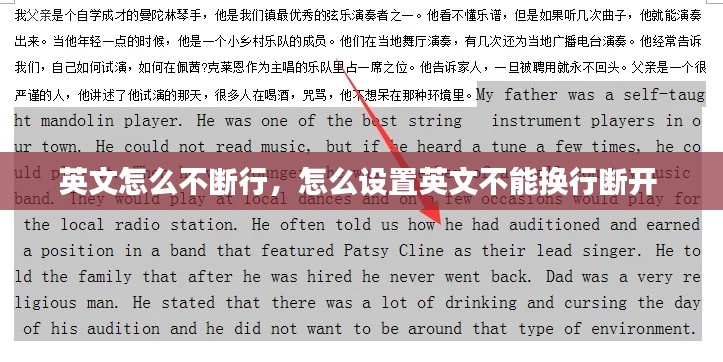Understanding the Concept of Word Wrapping in English
When it comes to writing in English, one common issue that often arises is the problem of text not breaking or wrapping properly. This can lead to a messy and unprofessional appearance of the document. To understand how to manage this, it's important to delve into the concept of word wrapping in English text.
What is Word Wrapping?
Word wrapping is the process of automatically moving text from one line to the next when it reaches the end of the current line. This is a standard feature in word processors and text editors, designed to ensure that the text flows smoothly across the page or screen. However, in English, certain considerations need to be taken into account to ensure that the text wraps correctly.
Characteristics of English Text that Affect Word Wrapping
English text has some unique characteristics that can impact how it wraps. Here are a few key points to consider:
Hyphens and Dashes: Words that are hyphenated or contain dashes can be problematic. If a hyphenated word is split across two lines, it can look awkward and disrupt the readability of the text. Similarly, dashes that are part of a sentence or a phrase should not be split.
Capitalization: The placement of capital letters at the beginning of a sentence can affect how the text wraps. If a capital letter is split across two lines, it can disrupt the visual flow of the text.
Numbers and Symbols: Numbers and other symbols should ideally remain together on the same line to maintain consistency and readability.
Tools and Techniques to Control Word Wrapping
Understanding the characteristics of English text can help you control how it wraps. Here are some tools and techniques you can use:
Use Word Wrapping Options: Most word processors and text editors have settings that allow you to control how text wraps. You can specify whether to wrap text at word boundaries, sentence boundaries, or by using specific characters as break points.
Manual Hyphenation: If you're working with a word processor, you can manually hyphenate words to ensure that they do not split at awkward places. This can be done by selecting the word and choosing the "Hyphenate" option.
Using Non-Breaking Spaces: If you need to keep certain elements together, such as numbers or symbols, you can use a non-breaking space (represented by in HTML or ^ by holding down the Alt key and typing 0160 on the numeric keypad) to prevent them from being split.
Formatting Guides: Some word processors allow you to create formatting guides that can help you align text and control where it wraps. These guides can be particularly useful for creating tables or columns.
Best Practices for Proper Word Wrapping
Here are some best practices to ensure that your English text wraps correctly:
Keep Hyphens and Dashes Together: Whenever possible, keep hyphenated words and dashes together on the same line. If this is not possible, use manual hyphenation to split them at appropriate points.
Capitalize at Sentence Boundaries: Ensure that capital letters are not split across lines. If a capital letter is near the end of a line, consider breaking the sentence at that point to maintain the integrity of the capitalization.
Use Non-Breaking Spaces Wisely: Use non-breaking spaces to keep elements together that should not be split, such as numbers, symbols, or titles.
Review Your Work: Always review your document after applying word wrapping settings to ensure that the text looks as intended and that there are no awkward breaks.
Conclusion
Proper word wrapping in English text is essential for maintaining readability and professionalism. By understanding the characteristics of English text and using the appropriate tools and techniques, you can ensure that your documents look clean and well-organized. Remember to keep an eye on hyphens, capitalization, and the use of non-breaking spaces to achieve the best results.
转载请注明来自安防监控安装,本文标题:《英文怎么不断行,怎么设置英文不能换行断开 》













 粤ICP备2021156384号-1
粤ICP备2021156384号-1
还没有评论,来说两句吧...